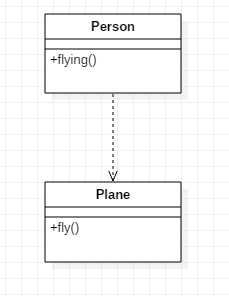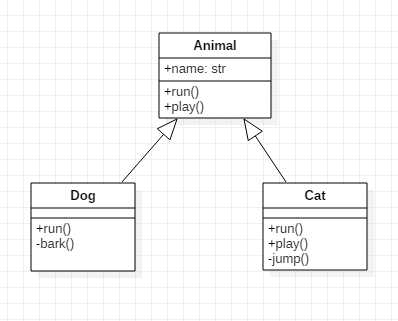标签:cme 静态 animal 派生类 info ane 实例化 复杂 end
在程序中需要把世间万物抽象成相应的类,现实世界中物与物之间的关系和程序中类与类之间的关系相对应,因为世间万物是普遍联系的,所以程序中类与类之间也不是孤立的。在系统分析和框架设计中,根据面向对象机制的三大特性:封装、继承、多态,归纳和扩展出类与类之间六种不同的关系:
- 依赖关系Dependency: 在局部变量,方法的形参,或者对静态方法的调用中实现
- 关联关系Association: 在类的成员变量中实现,可以双向也可以单向
- 聚合关系Aggregation: 强关联,整体与部分的关系,但是可分离
- 组合关系Composition: 更强关联,整体与部分的关系,不可分离
- 继承关系Generalization:类与类,或接口与接口之间的父子关系
- 实现关系Implementation: 接口或抽象类定义好的操作集合,由实现类完成接口或抽象类的具体操作
其实从更宽泛的角度来说,类与类之间的关系其实只有三种:继承、实现、关联(依赖是一种弱关联,聚合和组合是关联中的特例)。继承和实现是类与类之间的纵向关系,比如A类继承了B类,C类实现了D接口;而关联是类与类之间的横向关系,类与类之间的关联关系从弱到强依次为:依赖 < 关联 < 聚合 < 组合。
纵向的继承和实现关系很容易理解,横向的关联关系相对复杂些,尤其是对生命周期的不同处理,关联、聚合、组合只能结合上下文语义才好判断。下面就重点介绍下这些容易相互混淆的关联关系。
依赖关系(Dependency)
概念说明
可以简单地理解,依赖就是一个类A使用到了另一个类B,仅仅是“使用到”,类B本身并不属于类A,或者说类A并不拥有类B。依赖关系是偶然性的、临时性的,但是因为类B本身被类A引用到,所以B类的变化也会影响到类A。比较常见的场景就是人乘飞机从一地到另一地,飞机和人之间并没有所属关系,只是一种临时性的出行工具,此时人和飞机之间就是依赖关系。
代码实现
依赖关系在代码上体现为三种形式:
- 类B作为类A方法的形参
- 类B作为类A方法的局部变量
- 类A调用类B的静态方法
# 类B作为类A方法的形参 class Person(object): def flying(self, plane): plane.fly() class Plane(object): def fly(self): print ("The plane is flying.") >>> person = Person() >>> plane = Plane() >>> person.flying(plane) The plane is flying. >>>
# 类B作为类A方法的局部变量 class Person(object): def flying(self): self.plane = Plane() plane.fly() class Plane(object): def fly(self): print ("The plane is flying") >>> person = Person() >>> person.flying() The plane is flying. >>>
# 类A调用类B的静态方法 class Person(object): def flying(self): Plane.fly() class Plane(object): @staticmethod def fly(): print ("The plane is flying.") >>> person = Person() >>> person.flying() The plane is flying. >>>
UML类图
UML中使用带箭头的虚线表示,箭头指向表示调用关系,从类A指向类B

关联关系(Association)
概念说明
关联关系一般长期性的、拥有性的关系,而且双方的关系一般是平等的,如学校与学生之间、老师与学生之间。被关联类B以类的属性形式出现在关联类A中,关联可以是单向的,也可以是双向的。
依赖关系与关联关系的区别有动静之分,依赖关系的偶然性和临时性说明了动态性,关联关系的长期性、拥有性静态地展示了对被关联类的引用。
代码实现
关联关系在代码上体现为二种形式:
- 单向关联:单向拥有关系,只有一个类知道另一个类的属性和方法
- 双向关联:双向拥有关系,双方都知道对方的属性和方法
- 自身关联:自己关联自己,这种情况比较少但也有用到,如链表
# 单向关联
class Student(object): def __init__(self): self.title = "Seno"
def study(self): print ("Studying...") class School(object): def __init__(self): self.address = "ABC Street" self.student = Student() def act(self): print (self.student.title) self.student.study() >>> school = School() >>> school.act() Seno Studying... >>>
# 双向关联
class Student(object): def __init__(self): self.school = School() class School(object): def __init__(self): self.student = Student()
# 自身关联 class Node(object): def __init__(self): self.next = Node()
UML类图
UML中使用直线箭头表示,箭头指向为被关联的类,从类A指向类B
单向关联

双向关联

自我关联

聚合关系(Aggregation)
概念说明
聚合关系是也是关联关系的特例。普通关联关系的两个类一般处于同一平等层次上,而聚合关系的两个类处于不同的层次,是整体与部分的关系。聚合关系中的整体和部分是可以分离的,生命周期也是相互独立的,如公司与员工之间。
代码实现
聚合关系在代码上体现为:类A由类B聚合而成,类A包含有类B的全局对象,但类B的对象可以不在类A创建的时刻创建。
class School(object): def __init__(self): self.__students = [] def add_student(self, student): self.__students.append(student) class Student(object): pass >>> student = Student() >>> school = School() >>> school.add_student(student) >>>
UML类图
UML中使用空心菱形+实线箭头表示,空心菱形边指向类A(整体),实现箭头边指向部分类B(部分)

组合关系(Composition)
概念说明
组合关系也是关联关系的特例,属于强聚合,本身也表示整体与部分的关系,但是组合关系中的整体和部分是不可分离的,整体生命周期的结束时也是部分的生命周期到头时。如人和大脑。
聚合和组合其实都是关联的特例,都是整体与部分的关系。它们的区别在于整体和部分是否可分离,聚合的两个对象之间是可分离的,且具有各自的生命周期,而组合的两个对象往往表现为一种同命相连的关系。
代码实现
组合关系在代码上体现为在整体类的构造方法中直接实例化成员类,因为类组合关系中整体与部分是共生的。
class Person(object): def __init__(self): print ("Person Iinitialization Start") self.__brain = Brain() print ("Person Iinitialization End") def run(self): print ("Running...") class Brain(object): def __init__(self): print ("Brain Initialization Start") print ("Brain Initialization End") >>> person = Person() Person Iinitialization Start Brain Initialization Start Brain Initialization End Person Iinitialization End >>> person.run() Running... >>>
UML类图
UML中使用实心菱形+实线箭头表示,实心菱形边指向类A(整体),实线箭头边指向类B(部分)

继承关系(Generalization)
概念说明
继承指的是子类继承父类、或子接口继承父接口的功能并增加自己新功能的过程,是两个类之间耦合度最大的关系之一。父类称为基类或超类,子类也称为派生类。子类可以继承自抽象类或普通类。
代码实现
继承关系在代码上体现为二种形式:
- 子类继承自抽象类或普通类
- 子接口继承自父接口:适用于Java
# 子类继承自抽象类,必须实现父类中@abstractmethod修饰的抽象方法
from abc import ABCMeta, abstractmethod
class Animal(metaclass=ABCMeta): def __init__(self): self.name = "Animal" @abstractmethod def run(self): print ("Animal is running.") def play(self): print ("Animal is playing.") class Dog(Animal): def __init__(self): self.name = "Dog" def run(self): print ("Dog is running.") def __bark(self): print ("Dog is barking.") class Cat(Animal): def __init__(self): self.name = "Cat" def run(self): print ("Animal is running.") def play(self): print ("Cat is running.") def __jump(self): print ("Cat is jumping.") >>> dog = Dog() >>> cat = Cat() >>> dog.run() Dog is running. >>> dog.play() Animal is playing.>>> cat.run() Animal is running. >>> cat.play() Cat is running.>>>
# 子类继承自普通类,子类方法重写父类同名非私有方法
class Animal(object): def __init__(self): self.name = "Animal" def run(self): print ("Animal is running.") def play(self): print ("Animal is playing.") class Dog(Animal): def __init__(self): self.name = "Dog" def run(self): print ("Dog is running.") def __bark(self): print ("Dog is barking.") class Cat(Animal): def __init__(self): self.name = "Cat" def play(self): print ("Cat is running.") def __jump(self): print ("Cat is jumping.") >>> dog = Dog() >>> cat = Cat() >>> dog.run() Dog is running. >>> dog.play() Animal is playing.>>> cat.run() Animal is running. >>> cat.play() Cat is running.>>>
UML类图
UML中使用实线+空心箭头表示,箭头由子类指向父类、或子接口指向父接口

实现关系(Implementation)
概念说明
实现关系是指一个类实现一个或多个接口功能的过程,这里的接口更多的是一种契约或规范。实现是两个类之间或类与接口之间耦合度最大的关系之一,在这种关系中,类实现了接口或接口类中所声明的操作。
代码实现
实现关系在代码上体现为二种形式:
- 类具体实现接口中所声明的操作:如Java中支持原生interface,可以直接implement
- 类具体实现接口类中所声明的操作:如python中无原生interface,这里的接口类更多的是逻辑上的契约或规范
class Car(object): def engine(self): raise NotImplementedError class Benz(Car): def engine(self): print ("Benz is running.") class BMW(Car): def engine(self): print ("BMW is running.") >>> benz = Benz() >>> bmw = BMW() >>> benz.engine() Benz is running. >>> bmw.engine() BMW is running. >>>
UML类图
UML中使用虚线+空心箭头表示,箭头由实现类指向接口

标签:cme 静态 animal 派生类 info ane 实例化 复杂 end
原文地址:https://www.cnblogs.com/coolstream/p/9499299.html